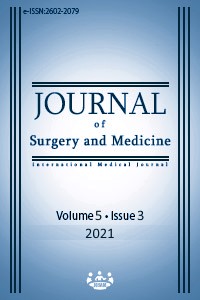The effect of edaravone on a rat fracture model complicated with ischemia
Keywords:
fracture healing, edaravone, ischemia-reperfusion injury, antioxidant agents, rat fracture modelAbstract
Background/Aim: Ischemia is a common issue in fracture healing due to vascular injury, compartment syndrome, and long-term tourniquet use. With ischemia-reperfusion injury, normal tissue repair can become complicated. In our study, we aimed to investigate the effect of edaravone on fracture union in a rat fracture model complicated with ischemia. Methods: We conducted our study on forty-four rats divided into four study groups and a control group, as follows: Group 1- Fracture, Group 2- Fracture-ischemia, Group 3- Fracture-ischemia-edaravone, Group 4- Fracture-edaravone, and Group 5- Control group. The control group comprised the contralateral intact tibia of the rats in Group 1 that were not complicated with ischemia and were not given edaravone treatment. The effects of edaravone on fracture healing were evaluated histologically, radiologically, and biomechanically. Results: There were no differences between the groups in terms of biomechanical and radiological indices, except for hardness values in the control subjects (Group 5), which were significantly higher than those of the other groups (P<0.05 for all). Similarly, in terms of histological evaluations of fracture healing between groups, group 3 has better improvement fracture healing scores than group 2 (P=0.042), and Group 4 has better improvement fracture healing scores than group 1 (P=0.049). Conclusion: These findings suggest that the administration of edaravone, independent of ischemia, had positive results on histopathological fracture healing.
Downloads
References
Yamamoto T, Yuki S, Watanabe T, Mitsuka M, Saito KI, Kogure K. Delayed neuronal death prevented by inhibition of increased hydroxyl radical formation in a transient cerebral ischemia. Brain Res. 1997;762:240-2. doi: 10.1016/s0006-8993(97)00490-3 PMID: 9262182
Garrett IR, Boyce BF, Oreffo R, Bonewald L, Poser J, Mundy GR. Oxygen-derived free radicals stimulate osteoclastic bone resorption in rodent bone in vitro and in vivo. J Clin Invest. 1990;85:632-9. doi: 10.1172/JCI114485.
Skjeldal S, Grøgaard B, Reikerås O, Müller C, Torvik A, Svindland A. Model for skeletal muscle ischemia in rat hindlimb: Evaluation of reperfusion and necrosis. Eur Surg Res. 1991;23:355-65. doi: 10.1159/000129176.
Lane JM, Sandhu H. Current approaches to experimental bone grafting. Orthop Clin North Am 1987; 18:213-25.
Huddleston PM, Steckelberg JM, Hanssen AD, Rouse MS, Bolander ME, Patel R. Ciprofloxacin inhibition of experimental fracture-healing. J Bone Joint Surg Am. 2000; 82:161-73 doi: 10.2106/00004623-200002000-00002.
Lu C, Miclau T, Hu D, Marcucio RS. Ischemia leads to delayed union during fracture healing: A mouse model. J Orthop Res. 2007; 25:51-61. doi: 10.1002/jor.20264
Cetinus E, Kilinç M, Uzel M, Inanç F, Kurutaş EB, Bilgic E, et al. Does long-term ischemia affect the oxidant status during fracture healing? Arch Orthop Trauma Surg. 2005; 125:376-80. doi: 10.1007/s00402-005-0825-3.
Lu C, Saless N, Wang X, Sinha A, Decker S, Kazakia G, et al. The role of oxygen during fracture healing. Bone. 2013; 52:220-9. doi: 10.1016/j.bone.2012.09.037
Wang WZ, Fang XH, Stephenson LL, Baynosa RC, Khiabani KT, Zamboni WA. Microcirculatory effects of melatonin in rat skeletal muscle after prolonged ischemia. J Pin Res. 2005; 39:57-65. doi: 10.1111/j.1600-079X.2005.00215.x.
Sheweita S, Khoshhal K. Calcium metabolism and oxidative stress in bone fractures: Role of antioxidants. Curr Drug Metab. 2007; 8:519-25. doi: 10.2174/138920007780866852.
Finkel T, Holbrook NJ. Oxidants, oxidative stress and the biology of ageing. Nature. 2000; 408:239. doi: 10.1038/35041687.
Adams HP, Zoppo G, Alberts MJ, et al. Guidelines for the early management of adults with ischemic stroke: The American Academy of Neurology affirms the value of this guideline as an educational tool for neurologists. Stroke 2007; 38:1655-711. doi: 10.1161/STROKEAHA.107.181486.
Okatani Y, Wakatsuki A, Kaneda C. Melatonin increases activities of glutathione peroxidase and superoxide dismutase in fetal rat brain. J Pineal Res. 2000; 28:89-96. doi: 10.1034/j.1600-079x.2001.280204.x.
Watanabe T, Yuki S, Egawa M, Nishi H. Protective effects of mci-186 on cerebral ischemia: Possible involvement of free radical scavenging and antioxidant actions. J Pharmacol Exp Ther. 1994; 268:1597-604.
Ikeda K, Iwasaki Y. Edaravone, a free radical scavenger, delayed symptomatic and pathological progression of motor neuron disease in the wobbler mouse. PLoS One 2015; 10:e0140316. doi: 10.1371/journal.pone.0140316. eCollection 2015.
Tsujimoto I, Hikoso S, Yamaguchi O, Kashiwase K, Nakai A, Takeda T, et al. The antioxidant edaravone attenuates pressure overload–induced left ventricular hypertrophy. Hypertension 2005; 45:921-6. doi: 10.1161/01.HYP.0000163461.71943.e9.
Zhang Z, Luo Z, Bi A, Yang W, An W, Dong X, et al. Compound edaravone alleviates lipopolysaccharide (lps)-induced acute lung injury in mice. Eur J Pharmacol. 2017; 811:1-11. doi: 10.1016/j.ejphar.2017.05.047.
Xi H, Akishita M, Nagai K, Yu W, Hasegawa H, Eto M, et al. Potent free radical scavenger, edaravone, suppresses oxidative stress-induced endothelial damage and early atherosclerosis. Atherosclerosis. 2007;191:281-9. doi: 10.1016/j.atherosclerosis.2006.05.040. P
Watanabe T, Tanaka M, Watanabe K, Takamatsu Y, Tobe A. Research and development of the free radical scavenger edaravone as a neuroprotectant. Yakugaki Zasshi. 2004; 124:99-112. doi: 10.1248/yakushi.124.99.
Hori K, Tsujii M, Lino T, Satonaka H, Uemura T, Akeda K, et al. Protective effect of edaravone for tourniquet-induced ischemia-reperfusion injury on skeletal muscle in murine hindlimb. BMC Musculoskelet Disord. 2013; 14:113. doi: 10.1186/1471-2474-14-113.
Yamamura M, Miyamoto Y, Mitsuno M, Ohata T, Tanaka H, Kobayashi Y, et al. Edaravone suppresses postoperative reperfusion injury in rat lower extremity: An immunohistological study. Int J Angiol. 2007; 16:17-9. doi: 10.1055/s-0031-1278238.
Yamamura M, Miyamoto Y, Mitsuno M, Tanaka H, Ryomoto M, Fukui S. Edaravone suppresses reperfusion injury following leg ischemia in rats: A transmission electron microscopic study. Int J Angiol. 2013; 22:267-70. doi: 10.1055/s-0033-1357261.
Naritomi H, Moriwaki H, Metoki N, Nishimura H, Higashi Y, Yamamoto Y, et al. Effects of edaravone on muscle atrophy and locomotor function in patients with ischemic stroke. Drugs in R D. 2010; 10:155-63. doi: 10.2165/11586550-000000000-00000.
Downloads
- 401 519
Published
Issue
Section
How to Cite
License
Copyright (c) 2021 Sezer Astan, Murat Aşçı, Orhan Balta, Erkal Bilgiç, Mehmet Burtaç Eren
This work is licensed under a Creative Commons Attribution-NonCommercial-NoDerivatives 4.0 International License.
















